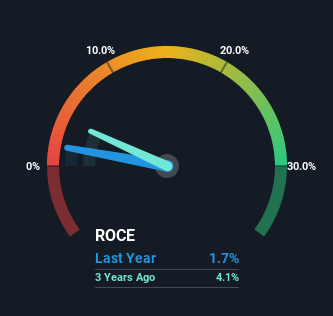- United States
- /
- Medical Equipment
- /
- NYSE:BLCO
These Return Metrics Don't Make Bausch + Lomb (NYSE:BLCO) Look Too Strong

When we're researching a company, it's sometimes hard to find the warning signs, but there are some financial metrics that can help spot trouble early. When we see a declining return on capital employed (ROCE) in conjunction with a declining base of capital employed, that's often how a mature business shows signs of aging. This reveals that the company isn't compounding shareholder wealth because returns are falling and its net asset base is shrinking. And from a first read, things don't look too good at Bausch + Lomb (NYSE:BLCO), so let's see why.
Return On Capital Employed (ROCE): What Is It?
Just to clarify if you're unsure, ROCE is a metric for evaluating how much pre-tax income (in percentage terms) a company earns on the capital invested in its business. Analysts use this formula to calculate it for Bausch + Lomb:
Return on Capital Employed = Earnings Before Interest and Tax (EBIT) ÷ (Total Assets - Current Liabilities)
0.017 = US$171m ÷ (US$11b - US$1.3b) (Based on the trailing twelve months to March 2023).
Therefore, Bausch + Lomb has an ROCE of 1.7%. Ultimately, that's a low return and it under-performs the Medical Equipment industry average of 9.1%.
View our latest analysis for Bausch + Lomb

In the above chart we have measured Bausch + Lomb's prior ROCE against its prior performance, but the future is arguably more important. If you're interested, you can view the analysts predictions in our free report on analyst forecasts for the company.
SWOT Analysis for Bausch + Lomb
- Net debt to equity ratio below 40%.
- Interest payments on debt are not well covered.
- Forecast to reduce losses next year.
- Has sufficient cash runway for more than 3 years based on current free cash flows.
- Good value based on P/S ratio and estimated fair value.
- Debt is not well covered by operating cash flow.
What The Trend Of ROCE Can Tell Us
In terms of Bausch + Lomb's historical ROCE movements, the trend doesn't inspire confidence. About three years ago, returns on capital were 4.1%, however they're now substantially lower than that as we saw above. On top of that, it's worth noting that the amount of capital employed within the business has remained relatively steady. Since returns are falling and the business has the same amount of assets employed, this can suggest it's a mature business that hasn't had much growth in the last three years. So because these trends aren't typically conducive to creating a multi-bagger, we wouldn't hold our breath on Bausch + Lomb becoming one if things continue as they have.
The Bottom Line On Bausch + Lomb's ROCE
All in all, the lower returns from the same amount of capital employed aren't exactly signs of a compounding machine. Despite the concerning underlying trends, the stock has actually gained 1.6% over the last year, so it might be that the investors are expecting the trends to reverse. Regardless, we don't like the trends as they are and if they persist, we think you might find better investments elsewhere.
If you're still interested in Bausch + Lomb it's worth checking out our FREE intrinsic value approximation to see if it's trading at an attractive price in other respects.
For those who like to invest in solid companies, check out this free list of companies with solid balance sheets and high returns on equity.
Valuation is complex, but we're here to simplify it.
Discover if Bausch + Lomb might be undervalued or overvalued with our detailed analysis, featuring fair value estimates, potential risks, dividends, insider trades, and its financial condition.
Access Free AnalysisHave feedback on this article? Concerned about the content? Get in touch with us directly. Alternatively, email editorial-team (at) simplywallst.com.
This article by Simply Wall St is general in nature. We provide commentary based on historical data and analyst forecasts only using an unbiased methodology and our articles are not intended to be financial advice. It does not constitute a recommendation to buy or sell any stock, and does not take account of your objectives, or your financial situation. We aim to bring you long-term focused analysis driven by fundamental data. Note that our analysis may not factor in the latest price-sensitive company announcements or qualitative material. Simply Wall St has no position in any stocks mentioned.
About NYSE:BLCO
Bausch + Lomb
Operates as an eye health company in the United States, Puerto Rico, China, France, Japan, Germany, the United Kingdom, Canada, Russia, Spain, Italy, Mexico, Poland, and internationally.
Undervalued with moderate growth potential.
Similar Companies
Market Insights
Community Narratives


